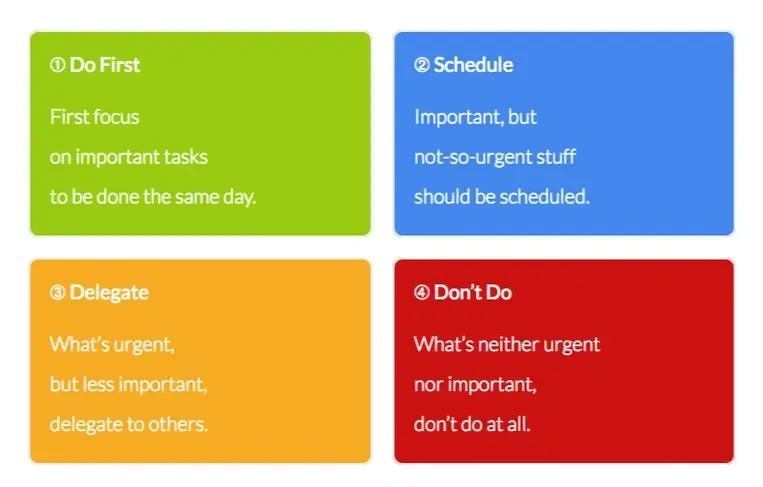Urgency vs. Importance | Presidential Tips for Time Management

President Eisenhower once said, "I have two kinds of problems: the urgent and the important. The urgent are not important, and the important are never urgent."
This principle forms the basis of the Eisenhower Matrix, which everyone (president or otherwise) can use to organize their time. The Eisenhower Matrix helps you to prioritize tasks based on urgency and importance so you can figure out what to do first—and in some cases, what to not do at all.
If you feel like you’re drowning in to-do lists or want to try a new time management technique, the Eisenhower Matrix may be right for you.
Why the Eisenhower principle works
Let’s start with some definitions:
- An urgent problem or task is something that needs to be dealt with right away, or at least very soon—for example, giving your boss the latest capital campaign numbers before the board of directors meeting tomorrow or figuring out why the online registration system for your annual volunteer day is malfunctioning.
- An important problem or task is something that contributes to your central mission or goals. These may be personal, professional, or organizational goals, depending on the task.
The first example above is both urgent and important—urgent because the meeting is tomorrow, and important because your boss’ presentation will inform the board’s decisions about the next stage of the capital campaign.
But, to President Eisenhower’s point, important tasks are not necessarily urgent. For example, implementing part of your organization’s strategic plan is important, but most days, it may not feel time-sensitive.
If you think about the possible combinations of urgent/less urgent and important/less important, you can start to see why analyzing both aspects is critical for success. If you spend all your time dealing with urgent tasks without assessing whether those things are important or not, then you’ll never have time for the important but less urgent tasks. And you may be wasting time on less important urgent tasks, when you really should be starting with the important and urgent items.
… Did we lose you? It will all make more sense when you look at the matrix.
The four quadrants of the Eisenhower Matrix

1. Do first
Tasks that are urgent and important go in the top left quadrant. Those are the tasks you should do first.
You can use strategies like the Pomodoro Technique to stay focused on those tasks before moving on. In the Pomodoro Technique, you split your time into 25-minute work sessions. Each one is known as a “pomodoro.” After each pomodoro, take a five-minute break; after four pomodoros (known as a “pomodori”), you’ve earned a longer break.
To combine the Pomodoro Technique with the Eisenhower Matrix, focus your first few pomodori on urgent and important tasks.
2. Schedule
Tasks that are less urgent, but still important, go in the top right quadrant. Schedule a time to do these tasks so you don’t lose track of them.
The Pomodoro Technique works here too. You can schedule a future pomodoro to work on these tasks. Even if you’re not using the Pomodoro Technique, putting a “work block” on your calendar—just like you would add a meeting—can help ensure that you actually get to the work.
3. Delegate
Tasks that are urgent but less important go in the bottom left quadrant and can be delegated to others. That way, they still get done while you can spend your time elsewhere.
Sometimes delegation is easier said than done. But if a task is truly urgent, and it’s not important for you to do that task, then you need to delegate it to someone else, whether that’s an intern, a junior staffer, or a peer.
One of our first examples—figuring out why the online registration system for your annual volunteer day is malfunctioning—can be a task that’s ripe for delegating. This task needs to be dealt with quickly, but it may not be important for you specifically to be the one to dig into the system and figure out what’s going on. You may be able to ask someone else to work with your IT team or the company that provided the registration platform to figure out what’s going on and then report back to you while you deal with other tasks.
Despite the “delegate” headline on this quadrant, there may be times when you have to do urgent but less important tasks. These might include attending a meeting where your expertise is needed or helping a colleague. It’s okay to keep these tasks on your to-do list; just make sure to prioritize the important and urgent items above others.
4. Don’t do
This quadrant may seem counterintuitive, but it’s one of the most important ones. If something you’re doing is neither urgent nor important, then maybe you shouldn’t be doing it at all. Technological distractions like checking social media or your personal email may belong in this quadrant.
How to get the most out of the Eisenhower Matrix
When you get a new task, project, or request, make sure you understand the level of urgency or importance. If one of those isn’t clear, ask! Without the pertinent information, you can’t use the Eisenhower Matrix properly.
Once you sort tasks, share the matrix with your supervisor and see if they agree with how you’ve assessed urgency and importance. They can also help you move things into the third quadrant if you're having trouble figuring out what tasks can be delegated to your colleagues.
The Eisenhower Matrix can also help you stay focused in a job search, especially if you’re unemployed and trying to add structure to your days. The urgent and important tasks may be things like completing a writing test or getting back to someone about scheduling an informational interview. Then, later in the day, you can schedule time to check the career pages of organizations you’re interested in—something that’s important but not quite urgent.
Even if all you do is assess the urgency and importance of a task before starting it—even without using the matrix—you’ll improve your productivity and time management. And you’ll have President Eisenhower to thank!
Did you enjoy this post? There's plenty more where this came from! Subscribe here for updates.
As a nonprofit advocacy professional living in Washington, D.C., Deborah works with groups across the country to educate their communities and lawmakers about public policies that can help low-income residents make ends meet. She is passionate about helping people connect their interests to a cause they believe in and empowering them to take action.


